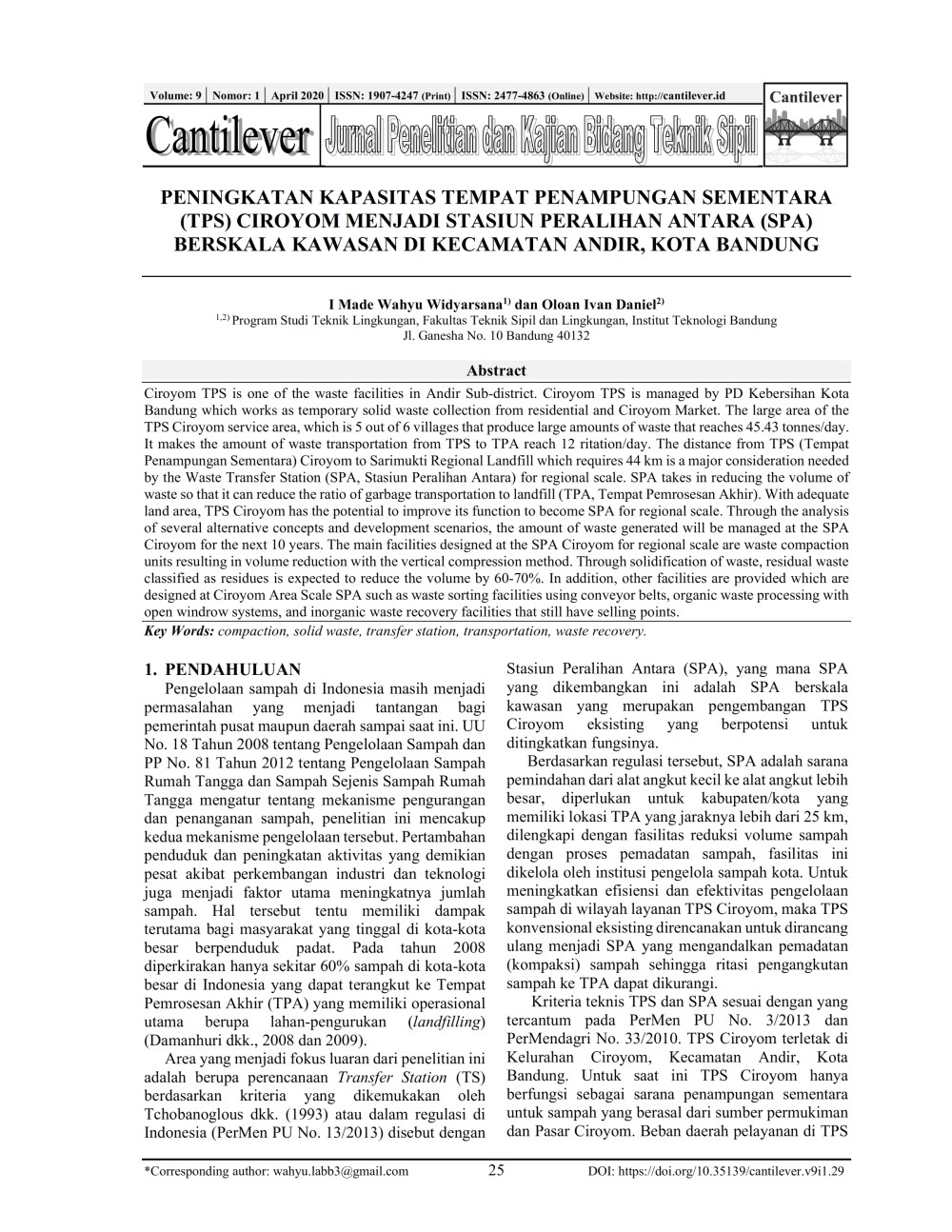Peningkatan Kapasitas Tempat Penampungan Sementara (TPS) Ciroyom Menjadi Stasiun Peralihan Antara (SPA) Berskala Kawasan di Kecamatan Andir, Kota Bandung Improving the Capacity of the Ciroyom Temporary Waste Collection to Become a Regional-Scale Waste Transfer Station in Andir District, Bandung City
Main Article Content
Abstract
Ciroyom TPS is one of the waste facilities in Andir Sub-district. Ciroyom TPS is managed by PD Kebersihan Kota Bandung which works as temporary solid waste collection from residential and Ciroyom Market. The large area of the TPS Ciroyom service area, which is 5 out of 6 villages that produce large amounts of waste that reaches 45.43 tonnes/day. It makes the amount of waste transportation from TPS to TPA reach 12 ritation/day. The distance from TPS (Tempat Penampungan Sementara) Ciroyom to Sarimukti Regional Landfill which requires 44 km is a major consideration needed by the Waste Transfer Station (SPA, Stasiun Peralihan Antara) for regional scale. SPA takes in reducing the volume of waste so that it can reduce the ratio of garbage transportation to landfill (TPA, Tempat Pemrosesan Akhir). With adequate land area, TPS Ciroyom has the potential to improve its function to become a SPA for regional scale. Through the analysis of several alternative concepts and development scenarios, the amount of waste generated will be managed at the SPA Ciroyom for the next 10 years. The main facilities designed at the SPA Ciroyom for regional scale are waste compaction units resulting in volume reduction with the vertical compression method. Through solidification of waste, residual waste classified as residues is expected to reduce the volume by 60-70%. In addition, other facilities are provided which are designed at Ciroyom Area Scale SPA such as waste sorting facilities using conveyor belts, organic waste processing with open windrow systems, and inorganic waste recovery facilities that still have selling points.
Downloads
Article Details
Badan Pusat Statistik Kota Bandung. (2017b). Kecamatan Andir dalam Angka Tahun 2017. Bandung: BPS Kota Bandung.
Badan Standardisasi Nasional Indonesia. (1994). SNI 19-3964-1994: Metode Pengambilan dan Pengukuran Contoh Timbulan dan Komposisi Sampah. Jakarta: BSNI.
Badan Standardisasi Nasional Indonesia. (2004). SNI 19-2454-2002 tentang Tata Cara Teknis Operasional Pengelolaan Sampah Perkotaan. Jakarta: BSNI.
Damanhuri, E., Widyarsana, I. M. W., Ramang, R., & Padmi, T. (2009). Evaluation of Municipal Solid Waste Flow in the Bandung Metropolitan Area, Indonesia. J Mater Cycles Waste Management (2009), 11, pp. 270-276.
Damanhuri, E. (2008). Challenges of Municipal Solid Waste Management in Indonesia: Implications of the Solid Waste Act 18/2008. The International Conference 2008 - the Sustainable Environmental Technology and Sanitation for Tropical Region, ITS, Surabaya, 18 – 19 November 2008.
Dinas Lingkungan Hidup Kota Bandung. (2017). Rencana Induk Persampahan Kota Bandung Tahun 2017-2037. Bandung: DLH Kota Bandung.
PP No. 81 Tahun 2012. (2012). Pengelolaan Sampah Rumah Tangga dan Sampah Sejenis Sampah Rumah Tangga. Jakarta: Sekretariat Negara.
PD Kebersihan Kota Bandung. (2016). Pengelolaan Sampah di Kota Bandung. Bandung.
Peraturan Presiden Republik Indonesia No. 97 Tahun 2017. (2017). Kebijakan dan Strategi Nasional Pengelolaan Sampah Rumah Tangga dan Sampah Sejenis Sampah Rumah Tangga. Jakarta: Sekretariat Negara.
Peraturan Menteri PU No. 03 Tahun 2013. (2013). Penyelenggaran Prasarana dan Sarana Persampahan Dalam Penanganan Sampah Rumah Tangga dan Sampah Sejenis Sampah Rumah Tangga. Jakarta: Sekretariat Negara.
Peraturan Menteri Dalam Negeri No. 33 Tahun 2010. (2010). Pedoman Pengelolaan Sampah. Jakarta: Sekretariat Negara.
Takaendengan, T. (2017). Optimasi Skenario Sistem Pengangkutan Sampah Yang Terintegrasi Dengan Tempat Pemrosesan Akhir (TPA) Regional (Studi Kasus Kota Manado). Bandung: Institut Teknologi Bandung.
Tchobanoglous, G., Theisen, H., & Vigil, S. A. (1993). Integrated Solid Waste Management. Mc Graw-Hill International Editions
Undang-Undang No. 18 Tahun 2008. (2008). Pengelolaan Sampah. Jakarta: Sekretariat Negara.
Widyarsana, I. M. W. (2019a). Circularity Tour Bali: Membangun Sistem Daur Ulang untuk Mewujudkan Bali yang Bersih. Materi Workshop Danone, Bali
Widyarsana, I. M. W., Damanhuri, E., Agustina, E., & Nur Aulia, R. (2019b). Risk Assessment and Rehabilitation Potential of Municipal Solid Waste Landfills in Bali Province, Indonesia. International Journal of GEOMATE, 17(63), pp. 164 - 171.
Widyarsana, I. M. W., Damanhuri, E., & Agustina, E. (2020a). Municipal solid waste material flow in Bali Province, Indonesia. J Mater Cycles Waste Manag, 22(8), pp. 405–415.
Widyarsana, I. M. W. & Agustina, E. (2020b). Waste Management Study In The Archipelago Tourism Area (Case Study: Nusa Penida District, Bali Province, Indonesia). E3S Web of Conf., 148 (2020)05002.

This work is licensed under a Creative Commons Attribution-NonCommercial 4.0 International License.
Authors who publish with this journal agree to the following terms:
- Authors retain copyright and grant the journal right of first publication with the work simultaneously licensed under a Creative Commons Attribution-NonCommercial 4.0 International License that allows others to share the work with an acknowledgment of the work's authorship and initial publication in this journal.
- Authors are able to enter into separate, additional contractual arrangements for the non-exclusive distribution of the journal's published version of the work (e.g., post it to an institutional repository or publish it in a book), with an acknowledgment of its initial publication in this journal.
- Authors are permitted and encouraged to post their work online (e.g., in institutional repositories or on their website) prior to and during the submission process, as it can lead to productive exchanges, as well as earlier and greater citation of published work (See The Effect of Open Access).
